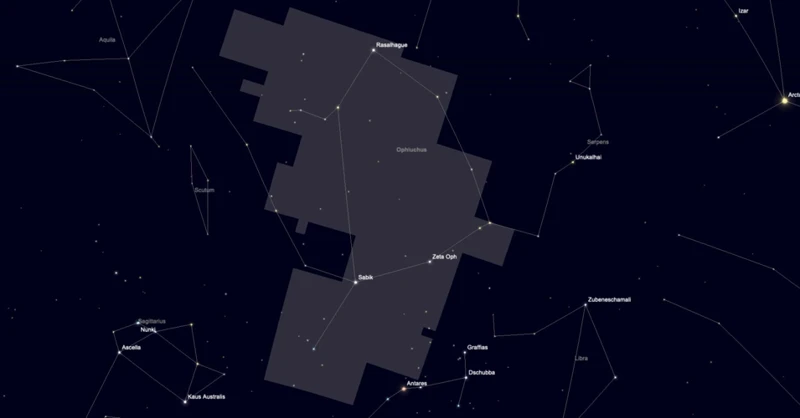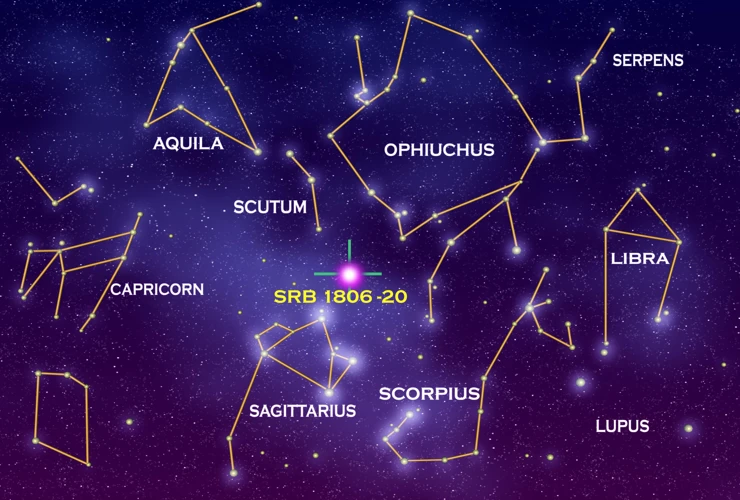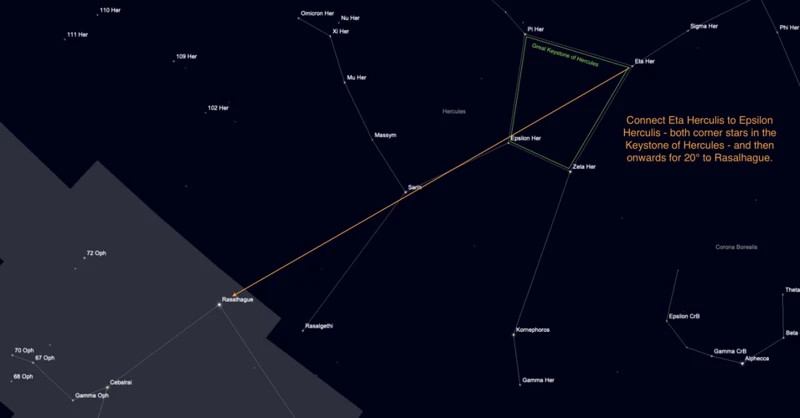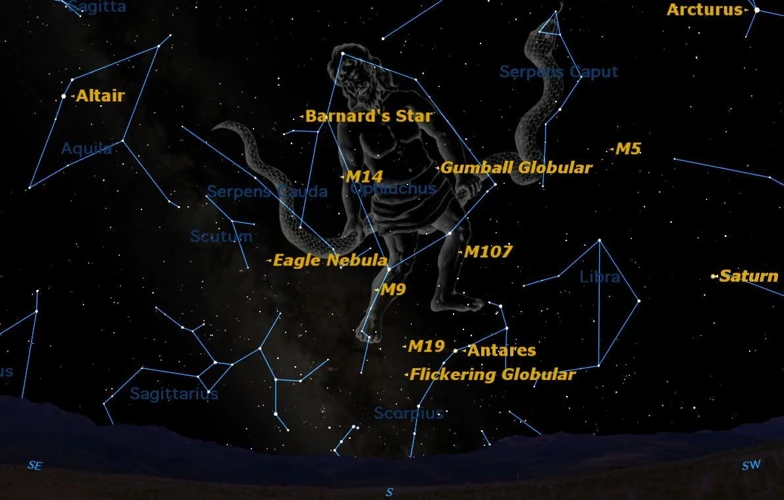Step into the enchanting world of the Centaurus constellation, a celestial wonder that mesmerizes astronomers and stargazers alike. Nestled in the vast expanse of the southern hemisphere, Centaurus boasts a rich tapestry of ancient mythology, breathtaking stars, and scientific intrigue. From its ancient origins and mythological significance to its distinct color and brightness, this article delves into the unique beauty of Centaurus, explores its prominent stars, and uncovers its mysteries and unanswered questions. So, grab your telescope and embark on a journey to discover the splendor that awaits in the heart of Centaurus.
Contents
- Overview of the Centaurus Constellation
- Characteristics of Centaurus Stars
- Observing Centaurus Constellation
- Scientific Significance and Discoveries
- Mysteries and Unanswered Questions
- Conclusion
-
Frequently Asked Questions
- 1. How can I locate the Centaurus constellation in the night sky?
- 2. What is the significance of the Centaurus constellation in ancient mythology?
- 3. Are there any famous deep-sky objects within the Centaurus constellation?
- 4. Is it true that Alpha Centauri is the closest star to our Sun?
- 5. What colors can I expect to see in the stars of Centaurus?
- 6. Can I observe Centaurus from the northern hemisphere?
- 7. Are there any exoplanets discovered within the Centaurus constellation?
- 8. How far away is the Centaurus constellation?
- 9. Can I observe any meteor showers associated with Centaurus?
- 10. Are there any celestial events or phenomena associated with Centaurus?
- References
-
Frequently Asked Questions
- 1. Can I see the Centaurus constellation from the Northern Hemisphere?
- 2. Is Centaurus a zodiac constellation?
- 3. How did Centaurus get its name?
- 4. What are some notable stars in the Centaurus constellation?
- 5. Are there any planets in the Centaurus constellation?
- 6. Can I observe the Centaurus constellation with the naked eye?
- 7. Are there any nebulae or galaxies in Centaurus?
- 8. What is the distance between Earth and Alpha Centauri?
- 9. Why is the Centaurus constellation important in astrophysical research?
- 10. Are there any ongoing exploration missions to the Centaurus constellation?
- References
- Read More
Overview of the Centaurus Constellation

Centaurus Constellation is a celestial marvel that has captivated human imagination for centuries. Located in the southern hemisphere, it is one of the largest constellations in the night sky. The name “Centaurus” is derived from the Greek mythological creature known as the Centaur, a half-human and half-horse hybrid. According to ancient legends, the Centaur represents Chiron, a wise and noble creature known for his mentorship of heroes.
Centaurus is easily identifiable by its prominent stars and distinctive shape. Its brightest star, Alpha Centauri, is a binary system consisting of three stars, including Proxima Centauri, the closest known star to our Sun. Other notable stars in Centaurus include Beta Centauri, also known as Hadar, and Omega Centauri, a globular cluster with beautiful star formations. These stars radiate with varying colors, from dazzling blue to warm orange, adding to the constellation’s allure.
The Centaurus constellation harbors several deep-sky objects, such as globular clusters, nebulae, and dwarf galaxies. Among them is the famous Centaurus A, a peculiar galaxy located approximately 10 million light-years away. Its unique appearance, resulting from a recent merger between a spiral galaxy and an elliptical galaxy, has allowed astronomers to study the process of galaxy evolution in detail.
The Centaurus constellation offers a treasure trove of celestial wonders for both amateur and professional astronomers to explore. Whether you are fascinated by its mythological origins, intrigued by its prominent stars, or eager to unravel the mysteries of deep space, Centaurus is a captivating destination in the vastness of the night sky. So, let your imagination soar as you embark on a cosmic journey through the marvelous Centaurus Constellation.
1. Ancient Origins and Mythology
The ancient origins and mythology surrounding the Centaurus constellation hold a deep significance in human culture. In Greek mythology, Centaurus represents the wise and benevolent creature Chiron, known for his teachings and guidance to legendary heroes such as Heracles and Jason. Chiron, half-human and half-horse, was renowned for his knowledge of medicine, music, and the arts. He occupies a unique place in mythology as one of the few Centaurs depicted as kind-hearted and just.
In ancient Greek culture, Centaurus was also associated with the constellation Sagittarius. According to the myth, Chiron was accidentally wounded by a poisoned arrow shot by Heracles. Unable to heal himself, Chiron willingly gave up his immortality to Prometheus, who transferred it to the titan Prometheus, thus relieving Chiron of his eternal suffering. As a tribute, Zeus placed Chiron among the stars, immortalizing his noble spirit in the form of the Centaurus constellation.
Beyond Greek mythology, the Centaurus constellation is also recognized in other cultures. In Indian astronomy, Centaurus represents the sage Kashyapa, who is believed to be the father of the Adityas, celestial deities associated with the Sun. The Aboriginal people of Australia have their own stories and interpretations of the celestial arrangement, connecting it to their rich cultural traditions and beliefs.
The enduring legacy of ancient mythology surrounding the Centaurus constellation reminds us of the profound connection between humans and the cosmos. It allows us to reflect on the wisdom and guidance imparted by mythical figures like Chiron and the universal themes they embody. The exploration of constellations like Centaurus provides a glimpse into the intricate tapestry of human imagination and our collective fascination with the stars above.
2. Centaurus: The Magnificent Centaur
Centaurus, the magnificent centaur, is a prominent figure in Greek mythology and a striking constellation in the night sky. In Greek lore, Centaurus was known as Chiron, a wise and noble creature revered for his teachings and mentorship of heroes. Depicted as a half-human, half-horse hybrid, this mythical being represents the unity of both human intellect and animalistic instincts.
One of the most notable features of Centaurus is its proximity to the Southern Cross, another famous constellation in the southern hemisphere. Together, they form a celestial duo that has guided navigators and explorers for centuries. Centaurus stands tall, stretching across the sky with its distinct shape resembling a rearing horse.
Within Centaurus lies Alpha Centauri, a triple star system that holds significant scientific importance. This system is composed of three stars: Alpha Centauri A, Alpha Centauri B, and Proxima Centauri. Proxima Centauri, the closest known star to our Solar System, is a red dwarf located approximately 4.24 light-years away. It captivates astronomers and space enthusiasts, igniting their curiosity and fueling dreams of interstellar exploration. Proxima Centauri is a beacon of hope, representing the possibilities of venturing beyond our own cosmic neighborhood.
Centaurus also boasts other notable stars, including Beta Centauri (Hadar) and Omega Centauri, a mesmerizing globular cluster. Hadar shines with an intense blue-white glow, adding to the constellation’s splendor. Omega Centauri, on the other hand, is a sight to behold. This globular cluster contains thousands of stars densely packed together in a spherical formation. Its captivating beauty has enticed astronomers to study its intricate structure and unravel its secrets.
Whether peering into the mythology that birthed Centaurus or marveling at the celestial wonders it holds, this magnificent centaur constellation continues to inspire awe and fascination. Its prominence in the southern hemisphere’s night sky invites us to gaze up and contemplate the vastness of the universe, sparking our imagination and reminding us of the endless possibilities that lie beyond our earthly realm. So, next time you look up at the stars and spot Centaurus, remember the rich mythology and the captivating scientific discoveries that make this constellation truly extraordinary.
3. Prominent Stars of Centaurus
The Centaurus constellation boasts an array of prominent stars that dazzle the night sky with their brilliance. Let’s explore three of these remarkable celestial bodies:
1. Alpha Centauri: Alpha Centauri is a triple star system and the closest stellar neighbor to our Sun, situated about 4.37 light-years away. It consists of three stars: Alpha Centauri A (also known as Rigil Kentaurus), Alpha Centauri B (also called Toliman), and Proxima Centauri. Proxima Centauri, the smallest of the three, is a red dwarf and holds the distinction of being the closest-known star to us. Positioned just over four light-years away, Proxima Centauri presents an enticing target for future interstellar exploration.
2. Beta Centauri (Hadar): Beta Centauri, also known by its traditional name Hadar, is another dazzling star in the Centaurus constellation. It shines as a blue-white supergiant, radiating with an intense brightness that is visible even to the naked eye. Hadar is approximately 390 light-years away from Earth and serves as a prominent navigational beacon for astronomers studying the heavens.
3. Omega Centauri: Omega Centauri is a captivating globular cluster that calls the Centaurus constellation home. This magnificent cluster is one of the largest and brightest in the sky, containing millions of stars tightly bound together by gravity. Its stellar population includes various stellar types, making it a celestial treasure trove for astronomers. Located around 15,800 light-years away, Omega Centauri presents a stunning sight through telescopes, with its tightly packed starry core surrounded by a halo of stars.
These prominent stars of the Centaurus constellation showcase the diverse and awe-inspiring nature of the celestial wonders that await exploration in the southern night sky. Whether you gaze upon Alpha Centauri, admire the brilliance of Beta Centauri, or marvel at the riches within Omega Centauri, these stellar gems offer a glimpse into the vast beauty of our universe.
Characteristics of Centaurus Stars

The stars of Centaurus constellation exhibit a range of remarkable characteristics that make them stand out in the night sky. One notable feature is their distinct color and brightness. Alpha Centauri, for instance, shines brightly with a dazzling yellow hue, while Beta Centauri captivates observers with its stunning blue-white radiance. These variations in color add depth and visual appeal to the constellation.
Centaurus is home to spectacular binary star systems. These systems consist of two stars orbiting around a common center of mass. Epsilon Centauri, also known as The False Cross, is a famous binary system that can be mistaken for the Southern Cross constellation. Its two components, Epsilon Centauri A and Epsilon Centauri B, are both blue-white giants, making for a captivating sight when observed through a telescope.
Additionally, Centaurus hosts a number of variable stars that exhibit intriguing fluctuations in brightness over time. One such variable star is R Centauri, a Mira-type star that undergoes regular pulsations, causing its luminosity to vary dramatically. Observing these variable stars can provide valuable insights into stellar evolution and help astronomers understand the life cycles of these celestial objects.
The stars of Centaurus constellation offer a fascinating array of characteristics. Their distinct colors, binary systems, and variable nature make them a captivating subject for astronomers and stargazers alike. Exploring the unique features of Centaurus stars allows us to appreciate the complexity and beauty of the cosmos, shining a light on the wonders that lie beyond our earthly realm.
1. Distinct Color and Brightness
The Centaurus constellation is renowned for its stars that showcase distinct colors and varying brightness. One prominent example is Alpha Centauri, the closest star system to our own, consisting of three stars: Alpha Centauri A, Alpha Centauri B, and Proxima Centauri. Alpha Centauri A shines with a bright yellow hue, similar to our Sun, while Alpha Centauri B radiates a slightly cooler orange color. Proxima Centauri, on the other hand, is a red dwarf star, giving off a faint red glow. This striking color contrast among the stars of Alpha Centauri adds to their allure and makes them a target of scientific curiosity. These stars demonstrate the extraordinary diversity found within the Centaurus constellation, showcasing a captivating blend of vibrant hues against the backdrop of the night sky. So, grab your telescope and witness the mesmerizing array of colors that grace the stars of Centaurus.
2. Spectacular Binary Systems
Spectacular Binary Systems are a captivating feature of the Centaurus constellation, showcasing the cosmic dance of two stellar companions. One of the most renowned binary systems in Centaurus is Alpha Centauri, consisting of three stars – Alpha Centauri A, Alpha Centauri B, and Proxima Centauri. Proxima Centauri, nestled in the closest proximity to our Sun, is a red dwarf star and has gained significant attention in the search for habitable exoplanets.
Another notable binary system in Centaurus is Beta Centauri, also known as Hadar. This brilliant pair of stars is located over 350 light-years away from Earth. Beta Centauri is a bright blue-white giant star that illuminates the night sky in the southern hemisphere. Its companion star, slightly less luminous, orbits around it, fueling the breathtaking spectacle of this celestial duo.
The study of binary systems not only ignites our curiosity about stellar dynamics but also provides valuable insights into stellar evolution and interaction. By observing the movement, mass, and properties of these binary systems, astronomers unravel the mysteries surrounding the birth and evolution of stars. The remarkable binary systems within the Centaurus constellation offer a captivating arena for this exploration, showcasing the intricate cosmic ballet of interconnected stars.
So grab your telescope and set your sights on the binary systems of Centaurus. Explore their mesmerizing orbits, marvel at their diverse properties, and unlock the secrets held within these celestial partnerships. The wonders of the Centaurus binary systems are sure to leave you in awe of the remarkable beauty and complexity of the universe.
3. Variable Stars and Their Intrigue
Variable stars within the Centaurus constellation bring an extra level of intrigue to the already captivating celestial landscape. These stars, aptly named for their fluctuating brightness, provide a unique opportunity for astronomers to study stellar evolution and gather invaluable data about the universe. One prime example is the variable star R Centauri, a red giant located in the heart of Centaurus. R Centauri undergoes periodic changes in brightness, which can be observed over several months. These variations in luminosity offer insights into the star’s internal processes, such as pulsation and mass loss. Another notable variable star in Centaurus is S Centauri, a Cepheid variable that serves as a crucial distance indicator for astronomers as they measure the vastness of the cosmos. By monitoring the changes in brightness of these variable stars, scientists gain a deeper understanding of stellar physics and the intricate mechanisms that govern the life cycles of celestial objects. Such knowledge is vital in unraveling the mysteries of the universe and advancing our understanding of the cosmos. So, as you gaze up at the brilliance of Centaurus, take a moment to appreciate the enigmatic dance of its variable stars, shedding light on the celestial wonders that surround us.
Observing Centaurus Constellation

Observing the Centaurus Constellation provides an opportunity to witness the celestial beauty of the southern hemisphere. To make the most of your stargazing experience, it is crucial to consider the best time and location for observing this captivating constellation. Centaurus reaches its highest point in the sky during the months of April to June, making it an ideal time to spot its prominent stars and deep-sky objects.
When it comes to choosing a location, it is important to find a place away from light pollution, such as urban areas, to fully appreciate the brilliance of the stars in Centaurus. Look for a dark and clear sky, preferably in a rural or remote area. It is also worth noting that observing Centaurus from the southern latitudes provides a more favorable view, as the constellation is located near the celestial South Pole.
To enhance your stargazing experience, it is recommended to use certain equipment and tools. A reliable telescope will allow you to observe the intricate details of the stars and deep-sky objects within Centaurus. Additionally, a pair of binoculars can be handy for spotting star clusters and other fainter celestial phenomena. Consider using a star chart or mobile app to help navigate the night sky and identify the key stars and objects within Centaurus.
Here are a few tips to spot some of the key stars in Centaurus. Start by locating the Southern Cross, a prominent asterism in the southern hemisphere. From there, move your gaze towards the east to find Alpha Centauri, the brightest star in the constellation. It is part of a triple star system and can be easily spotted with the naked eye. Beta Centauri, also known as Hadar, lies nearby and shines with a distinct orange hue. Omega Centauri, a remarkable globular cluster, can be found by tracing a line from Beta Centauri towards the west.
Observing the Centaurus Constellation is a rewarding experience that allows you to connect with the wonders of the universe. So, find a dark and clear location, equip yourself with the necessary tools, and prepare for an awe-inspiring journey through the celestial realm of Centaurus.
1. Best Time and Location for Observing
When it comes to observing the celestial wonders of the Centaurus constellation, timing and location play crucial roles in optimizing your stargazing experience. The best time for observing Centaurus is during the southern hemisphere’s winter months, which typically fall between June and August. During this time, Centaurus is positioned high in the night sky, offering excellent visibility and minimizing atmospheric interference.
To fully enjoy the splendor of Centaurus, it is advisable to find a location with minimal light pollution. Ideally, venture away from city lights and seek out dark sky areas, such as national parks or observatories. This will ensure that the stars in Centaurus shine brightly and reveal their true brilliance.
Additionally, it is worth considering the moon phase when planning your observing session. To observe fainter objects in Centaurus, such as galaxies and nebulae, choose nights when the moon is in its crescent phase or when it has set, as a bright moon can wash out the delicate details of these celestial wonders.
Remember to dress warmly and bring comfortable seating arrangements, as observing the night sky may require long periods of waiting and patience. Binoculars or a telescope with suitable magnification can enhance the experience by bringing out finer details and allowing you to explore Centaurus’ deep-sky objects with precision.
So, find the perfect timing, scout out a dark location free from light pollution, and prepare your observing tools for an unforgettable journey through the captivating wonders of the Centaurus constellation. And while you marvel at the celestial beauty above, you might even catch a passing meteor or two, adding an extra touch of magic to your experience.
2. Equipment and Tools for Stargazing
When it comes to stargazing in the Centaurus constellation, having the right equipment and tools is crucial for a memorable experience. Here are some essential items to enhance your celestial observations:
1. Telescope: Invest in a good-quality telescope with a decent aperture to gather enough light for clear views of the stars and deep-sky objects. Reflector telescopes are popular for their affordability and versatility, while refractor telescopes offer crisp images.
2. Binoculars: Don’t underestimate the power of binoculars in stargazing. They provide a wider field of view, making it easier to locate stars and constellations. Compact and portable, binoculars are ideal for beginners and for observing celestial events like meteor showers.
3. Star Maps/Charts: A star map or chart is an indispensable tool to navigate the night sky. Choose ones specifically designed for the southern hemisphere to easily locate Centaurus and its celestial neighbors. You can also use astronomy apps or software that utilize GPS to provide real-time sky maps.
4. Red LED Flashlight: To preserve your night vision while reading star maps or adjusting equipment, use a red LED flashlight. Red light doesn’t disrupt your eyes’ adaptation to the darkness and allows you to see the sky without losing clarity.
5. Observing Chair: Comfort is key during long stargazing sessions. An adjustable observing chair provides stability and ensures you maintain a relaxed position while scanning the heavens. Look for models with a padded seat and a height-adjustable feature.
6. Warm Clothing and Accessories: Stargazing can be a chilly endeavor, especially during late-night observations. Dress in layers and consider wearing thermal undergarments, gloves, and hats to keep warm. Don’t forget to bring a comfortable blanket or reclining chair for added comfort.
Remember, the key to successful stargazing is not just the equipment, but also the right conditions. Find a location away from light pollution, preferably in an open area with an unobstructed view of the sky. With the proper equipment and a sense of adventure, you’ll be ready to immerse yourself in the breathtaking beauty of the Centaurus constellation and discover the captivating secrets it holds.
3. Tips for Spotting Key Stars
When it comes to spotting key stars in the Centaurus constellation, a few tips can help enhance your stargazing experience. Firstly, it’s essential to find a location away from light pollution, preferably in a dark rural area or an observatory with clear skies. This will ensure optimal visibility for spotting celestial objects.
Secondly, familiarize yourself with the prominent stars of Centaurus. Alpha Centauri, the closest star system to Earth, is a great starting point. Look for its distinctive blue-white glow and its companion star, Beta Centauri, which shines with a captivating blue hue.
Another fascinating star to observe is Omega Centauri, a bright globular cluster that appears as a fuzzy patch in the night sky. You can spot it using a pair of binoculars or a telescope with low magnification.
For those interested in deep sky objects, Centaurus A, the peculiar galaxy, is worth capturing with a telescope. Its elongated shape and dark dust lanes can be seen with moderate magnification.
To enhance your stargazing experience, make use of helpful smartphone apps or online star charts that provide real-time information about the positions of stars and celestial objects in the night sky. These tools can help you identify and locate specific stars within the Centaurus constellation more easily.
With these tips in mind, venture into the night and allow the splendor of Centaurus to unfold before your eyes. Whether you are a seasoned astronomer or a curious beginner, the Centaurus constellation offers a captivating celestial spectacle that will leave you in awe of the magnificence of our universe.
Scientific Significance and Discoveries

Scientific research on the Centaurus constellation has yielded significant discoveries and contributed to our understanding of the universe. Astronomers have conducted extensive studies on the stars within Centaurus, unveiling insights into stellar evolution, binary systems, and exoplanets.
One area of astrophysical research focuses on the distinct populations of stars within Centaurus. By analyzing the color, brightness, and spectral characteristics of these stars, scientists can determine their ages, compositions, and evolutionary paths. This research has led to the identification of different stellar populations, providing valuable insights into the formation and evolution of galaxies.
Centaurus is also home to numerous binary star systems, where two stars orbit around a common center of mass. These systems offer opportunities to study stellar companionship and interactions, shedding light on the dynamics of stellar evolution. Notable examples include Epsilon Centauri, a double star system with two giant stars, and Mu Centauri, a binary system with one star in the late stages of its life. These systems have provided crucial data for understanding the life cycles and fates of stars.
The Centaurus constellation has played a pivotal role in the discovery of exoplanets. By observing the slight dimming of a star’s brightness caused by a planet passing in front of it, known as the transit method, astronomers have detected multiple exoplanets within Centaurus. Notable examples include HD 10180, a star system with at least seven confirmed exoplanets, and Beta Centauri, a binary star system with a confirmed hot Jupiter exoplanet. These discoveries expand our knowledge of planetary systems, their diversity, and the potential for habitable worlds beyond our solar system.
In addition to these scientific breakthroughs, ongoing research continues to unravel the mysteries of the Centaurus constellation. Astronomers are investigating the potential presence of hidden binary systems and unexplored celestial objects within Centaurus, aiming to enhance our understanding of stellar evolution, galaxy formation, and the universe as a whole.
Through the dedicated efforts of astronomers and the wealth of data provided by advanced telescopes and observatories, the scientific study of the Centaurus constellation has made significant contributions to our knowledge of the cosmos. From deciphering the secrets of star formation and evolution to discovering distant exoplanets, Centaurus continues to provide invaluable insights into the vastness and complexity of the universe.
1. Astrophysical Research on Centaurus
Astrophysical research on the Centaurus constellation has provided valuable insights into the nature of stars, galaxies, and the universe itself. Scientists have conducted extensive studies to unravel the mysteries of this celestial wonder. One area of focus is the exploration of stellar evolution within Centaurus. By observing the lifecycle of stars in the constellation, astronomers can better understand the processes of star formation, nuclear fusion, and eventual stellar death.
Another intriguing aspect of astrophysical research on Centaurus is the study of galaxies and their interactions. Centaurus A, the peculiar galaxy mentioned earlier, has been a subject of intense study. Scientists have used various instruments, including radio telescopes and X-ray observatories, to examine the intricate structures and powerful outflows within this galaxy. The discoveries made within Centaurus A have contributed to our understanding of galaxy mergers, active galactic nuclei, and the role of supermassive black holes in galactic evolution.
In addition to galaxies, Centaurus is a fascinating region for exploring star clusters and nebulae. Stellar clusters, like the aforementioned Omega Centauri, provide valuable insights into the formation and dynamics of densely packed stars. Nebulae within Centaurus, such as the Lambda Centauri Nebula, offer a window into the birthplaces of new stars and the creation of molecular clouds.
Technological advancements, such as space telescopes and high-resolution spectrographs, have enabled scientists to uncover exoplanets within the Centaurus constellation. These discoveries have fueled the search for habitable worlds beyond our solar system and have shed light on the prevalence and diversity of planetary systems in the universe. Understanding exoplanets within Centaurus allows researchers to draw comparisons to our own solar system and speculate about the potential for extraterrestrial life.
Astrophysical research on Centaurus continues to push the boundaries of our knowledge, revealing new insights into the nature of the cosmos. The wealth of data gathered by scientists studying this constellation provides a foundation for further exploration and discovery. As technology advances, our understanding of Centaurus and its astrophysical significance will only deepen, offering glimpses into the wonders of the universe that surrounds us. So, let us marvel at the ongoing research and revelations that Centaurus brings forth.
2. Exoplanets and Their Host Stars
Exoplanets, celestial bodies that orbit stars outside our solar system, have become a topic of great interest in astronomical research. The Centaurus constellation has played a significant role in the study of exoplanets and their host stars. Many exoplanets have been discovered within the Centaurus constellation, providing valuable insights into the diversity of planetary systems in our galaxy.
One notable exoplanet discovery within Centaurus is HD 10180, a star system located approximately 127 light-years away. This system is known for its remarkable resemblance to our own solar system, with at least five confirmed planets orbiting around its host star. The discovery of such exoplanetary systems provides valuable data for researchers studying planetary formation and the potential for habitable environments outside of our own planet.
In addition to HD 10180, other exoplanets have been found within the Centaurus constellation, each adding to our understanding of planetary systems in the universe. These discoveries have been made using various techniques, such as the radial velocity method and the transit method, which allow astronomers to detect the gravitational influence or the periodic dimming of the host star as a planet passes in front of it.
The study of exoplanets in the Centaurus constellation not only contributes to our scientific knowledge but also fuels our sense of wonder and curiosity about the vastness of the cosmos. By exploring these distant worlds and their host stars, we gain a glimpse into the potential for life beyond Earth and the intricacies of the universe we inhabit.
As advancements in technology and observational techniques continue to improve, it is likely that more exoplanets within Centaurus and other constellations will be discovered in the future. These discoveries deepen our understanding of the cosmos, inspiring further exploration and pushing the boundaries of our knowledge.
So, as we gaze upon the myriad of stars within the Centaurus constellation, let us marvel at the possibility of countless exoplanets and the mysteries they hold. The study of exoplanets and their host stars in Centaurus fuels our curiosity and opens new doors to unraveling the secrets of the universe.
Mysteries and Unanswered Questions

Mysteries abound within the Centaurus Constellation, enticing astronomers and researchers with unanswered questions that continue to perplex and inspire. One of the intriguing mysteries lies in the hidden binary systems within Centaurus. Despite extensive research, astronomers have only scratched the surface, with numerous undetected binary star systems waiting to be uncovered. These hidden pairs of stars, locked in an eternal gravitational dance, hold the potential to deepen our understanding of stellar evolution and dynamics.
Another captivating mystery is the unexplored regions and celestial objects within Centaurus. While many parts of the constellation have been extensively studied, there are still vast areas waiting to be explored and cataloged. Within these uncharted territories lie the possibilities of discovering new star clusters, nebulae, and even distant galaxies, enticing astronomers with the allure of the unknown.
Centaurus has also sparked curiosity with its potential for uncovering exoplanets and their host stars. With advances in technology and the advent of space-based observatories, scientists have begun to detect exoplanets in distant star systems. Exploring Centaurus offers a unique opportunity to study exoplanets in detail, helping us better understand their formation, composition, and potential habitability.
As our understanding of the universe deepens, the mysteries surrounding Centaurus will continue to captivate and drive scientific exploration. By studying its hidden binary systems, venturing into unexplored regions, and uncovering the secrets of exoplanets, astronomers are gradually unraveling the enigmatic nature of this mesmerizing southern constellation. So, join in the quest for knowledge and venture into the cosmic wonders of Centaurus.
Hidden within the enchanting Centaurus constellation lie fascinating binary systems, a celestial marvel that adds to the allure of this cosmic wonder. Binary systems are formed when two stars are gravitationally bound to each other, orbiting around a shared center of mass. While many binary systems are easily observable, there are hidden gems within Centaurus that continue to intrigue astronomers. These hidden binary systems often require advanced telescopes and observation techniques to unveil their secrets. One such example is the binary star system Epsilon Centauri, which consists of two massive stars orbiting each other. Their interactions create stunning stellar phenomena, such as stellar winds and intense magnetic fields. Another intriguing binary system is Mu Centauri, where two stars rotate around each other in a dance of stellar harmony. These hidden binary systems offer a glimpse into the complexities of stellar evolution and the dynamics of celestial objects. Exploring and studying these elusive binary systems within the Centaurus constellation opens a doorway to unraveling the cosmic mysteries that lie within our vast universe.
2. Unexplored Regions and Celestial Objects
Unexplored regions and celestial objects within the Centaurus constellation hold an air of mystery and intrigue. Despite extensive exploration, there are still parts of Centaurus that remain uncharted and unknown to astronomers. These unexplored regions present an exciting opportunity for future observations and discoveries.
One such unexplored area is the outer reaches of Centaurus, where distant galaxies and clusters await exploration. These regions hold the potential to reveal new insights into the formation and evolution of galaxies, providing valuable data for astronomers studying the cosmic web of the universe. By utilizing advanced telescopes and instruments, scientists hope to uncover hidden celestial objects, such as dwarf galaxies and intergalactic gas clouds, that could contribute to our understanding of the universe’s vastness.
Additionally, within Centaurus lie numerous unexplored deep sky objects. A notable example is the open star cluster known as NGC 3766, which shines brightly with its young and vibrant stars. Despite its beauty, NGC 3766 remains relatively understudied, leaving ample room for future investigations into its stellar composition, age, and formation processes.
Exploration of these uncharted regions and celestial objects requires cutting-edge technology and dedicated research efforts. By delving into these unexplored frontiers, astronomers have the potential to make groundbreaking discoveries that will expand our knowledge of the universe and its intriguing secrets.
So, as the boundaries of exploration expand and new telescopes are deployed, we eagerly await the unveiling of these unexplored realms within the Centaurus constellation. Only time will reveal the wonders that await us in the depths of the cosmic unknown.
Conclusion

In conclusion, the Centaurus constellation enchants us with its unique beauty, rich mythology, and scientific significance. From the ancient tales of the wise Centaur to the spectacular binary systems and variable stars, Centaurus is a celestial wonder that continues to inspire and fascinate. The distinct colors and brightness of its stars add to the captivating allure of this constellation, making it a favorite among stargazers and astronomers alike.
Observing the Centaurus constellation provides a rewarding experience, especially during the optimal time and in the right location. With the right equipment and tools, such as telescopes and star charts, one can delve deeper into the wonders of this constellation and spot its key stars with ease. Whether you are an amateur astronomer or a seasoned expert, Centaurus offers a wealth of celestial treasures waiting to be explored and studied.
Moreover, the scientific significance of Centaurus goes beyond its visual appeal. Through astrophysical research, scientists have made remarkable discoveries about the nature of Centaurus stars, delving into the mysteries of their origins, evolution, and interactions. The study of exoplanets in the Centaurus constellation has also played a crucial role in expanding our knowledge of the universe and the possibility of life beyond Earth.
While Centaurus continues to unveil its secrets, there are still mysteries to be unraveled. The hidden binary systems and unexplored regions within Centaurus present intriguing opportunities for future research and exploration. As astronomers embark on new missions and advancements in technology enable us to peer deeper into the cosmos, the secrets of Centaurus are sure to be revealed, bringing us closer to understanding the vastness and beauty of our universe.
In the grand tapestry of the night sky, the Centaurus constellation stands as a testament to the wonders of the cosmos. Its unique blend of mythology, distinct stars, and scientific significance make it a cherished gem in the southern hemisphere. So, whether you are fascinated by ancient legends, astrophysical research, or simply the beauty of the stars, a journey into the heart of Centaurus promises an unforgettable adventure through the depths of space.
References:
– Meteors, Astronomy, and Space Exploration
– Exploring the Significance of Ophiuchus in Astrology
– Fire Sign Compatibility in Astrology
Frequently Asked Questions

1. How can I locate the Centaurus constellation in the night sky?
The Centaurus constellation is best visible from the southern hemisphere. Look for its distinctive shape, resembling a centaur or a horse with its head held high, in the direction of the south.
2. What is the significance of the Centaurus constellation in ancient mythology?
In Greek mythology, Centaurus represents the wise and noble Chiron, a mentor to heroes and revered for his knowledge and guidance.
3. Are there any famous deep-sky objects within the Centaurus constellation?
Absolutely! One of the most prominent objects is Centaurus A, a fascinating galaxy resulting from a recent merger between a spiral and an elliptical galaxy. This peculiar galaxy offers valuable insights into the process of galaxy evolution.
4. Is it true that Alpha Centauri is the closest star to our Sun?
Indeed! Alpha Centauri is a binary star system consisting of three stars, with Proxima Centauri being the closest to our Sun, located approximately 4.24 light-years away.
5. What colors can I expect to see in the stars of Centaurus?
The stars in Centaurus vary in color, ranging from dazzling blue to warm orange, each adding to the constellation’s visual appeal.
6. Can I observe Centaurus from the northern hemisphere?
No, unfortunately, Centaurus is not visible from the northern hemisphere. It is exclusively seen from latitudes south of 25 degrees N.
7. Are there any exoplanets discovered within the Centaurus constellation?
While exoplanet discoveries have been made in other constellations, none have been specifically attributed to Centaurus constellation as of yet. Scientists continue to explore and make new discoveries every day.
8. How far away is the Centaurus constellation?
The Centaurus constellation lies at a distance of approximately 300 light-years from Earth.
9. Can I observe any meteor showers associated with Centaurus?
No, there are no known meteor showers associated with the Centaurus constellation. However, there are several meteor showers throughout the year that occur in different parts of the night sky.
10. Are there any celestial events or phenomena associated with Centaurus?
While there are no specific celestial events uniquely tied to Centaurus, it remains a sought-after constellation for its stunning stars, deep-sky objects, and mythology.
References
- Centaurus Constellation: Stars, Myth, Facts, Location
- How to Find Centaurus the Centaur Constellation – YouTube
Frequently Asked Questions

1. Can I see the Centaurus constellation from the Northern Hemisphere?
No, the Centaurus constellation is primarily visible from the Southern Hemisphere. Its location close to the celestial South Pole makes it difficult or impossible to see from most parts of the Northern Hemisphere.
2. Is Centaurus a zodiac constellation?
No, Centaurus is not one of the 12 zodiac constellations. The zodiac constellations are a specific set of constellations that lie along the ecliptic, the apparent path of the Sun across the sky. Centaurus is located far away from the ecliptic.
3. How did Centaurus get its name?
The name “Centaurus” comes from Greek mythology. It is associated with the mythical creature known as the Centaur, which is half-human and half-horse. The constellation represents the centaur Chiron, who was known for his wisdom and mentorship.
4. What are some notable stars in the Centaurus constellation?
The Centaurus constellation is home to several prominent stars. Some of the most notable ones include Alpha Centauri, the closest star system to our solar system, and Beta Centauri, a bright blue giant star. There are also many other visually striking stars in this constellation.
5. Are there any planets in the Centaurus constellation?
Yes, several exoplanets have been discovered in star systems within the Centaurus constellation. These planets orbit their respective host stars and offer valuable insights into the formation and diversity of planetary systems in our galaxy.
6. Can I observe the Centaurus constellation with the naked eye?
Yes, many of the stars in the Centaurus constellation are visible to the naked eye, especially from dark sky locations in the Southern Hemisphere. However, a pair of binoculars or a telescope can enhance the viewing experience and allow you to see more details.
7. Are there any nebulae or galaxies in Centaurus?
Yes, Centaurus is home to a number of fascinating nebulae and galaxies. One of the most prominent ones is the Centaurus A galaxy, which is a nearby radio galaxy with an active galactic nucleus. There are also several planetary nebulae and other galaxies worth exploring.
8. What is the distance between Earth and Alpha Centauri?
Alpha Centauri, the closest star system to our solar system, is located about 4.37 light-years away. In terms of distance, this makes it the closest star system to us, even though it still takes over four years for its light to reach us.
9. Why is the Centaurus constellation important in astrophysical research?
Centaurus is of great significance in astrophysical research due to its abundance of bright stars, as well as its proximity to our own solar system. It provides valuable opportunities for studying stellar evolution, binary star systems, and other astrophysical phenomena.
10. Are there any ongoing exploration missions to the Centaurus constellation?
Currently, there are no specific exploration missions targeted solely at the Centaurus constellation. However, various telescopes and observatories around the world continue to study and observe the stars and celestial objects within this captivating constellation.
References
- How to Find Centaurus the Centaur Constellation – YouTube
- Centaurus Constellation | Facts, Myths & How To Find The …
- Exploring the riches of the Southern Cross







